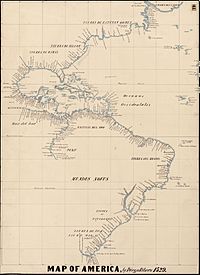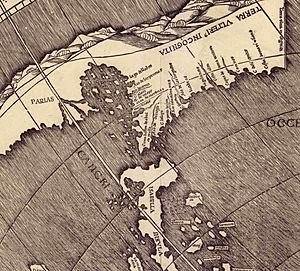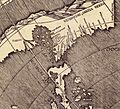Ajacan facts for kids
Ajacán was a Spanish settlement that didn't last long, existing only from 1570 to 1571. It was located near the Chesapeake Bay, in what is now Virginia. The Spanish also called it by other names like Xacan, Jacan, Iacan, Axaca, and Axacam.
The Spanish hoped Ajacán would become the main city of a much larger Spanish colony called the Province of Axacan. This province would have covered the area we now know as the Mid-Atlantic region of the United States. Father Juan Bautista de Segura and his group were among those who called this area Axacan.
Some historians once thought that early Spanish explorers sailed up the Potomac River to a place called Occoquan. They believed this because "Axacan" sounded similar to the name of an Indian town there. However, records show that the Spanish mission in Axacan failed in 1570. Their guide left them, and most of the group were killed.
Contents
Spanish Explorers in North America
Many Spanish explorers sailed to the Americas. They were looking for new lands and resources.
Early Voyages to Chesapeake Bay
Francisco Fernández de Écija, a Spanish pilot, believed that Lucas Vázquez de Ayllón's failed colony from 1526-27, called San Miguel de Gualdape, was near Jamestown on the James River. However, most modern historians think Ayllón's colony was actually much further south, in Georgia.
In 1525, Estêvão Gomes explored the coast and may have named the Chesapeake Bay "Immaculate Conception Bay." The name Axacan wasn't recorded until 1559-60. This is when Dominican missionaries took a Native American man from there. They named him Don Luis. Don Luis was later recorded in Viceroyalty of New Spain (Mexico) in 1565.
Searching for the Northwest Passage
In 1561, Pedro Menéndez de Avilés believed he could find the Northwest Passage. This was a sea route through North America to the Pacific Ocean. He thought rivers flowing from the Allegheny Mountains could connect to rivers on the other side that led to the Pacific. Native Americans in the Axacan area told him about these mountains.
Later, in 1588, Vincente Gonzalez visited a bay. Natives there told him about an English settlement to the north. He didn't name the bay. But in 1606, Governor of Florida Juan Menéndez Márquez said this trip was to the Bay of Jacan. Many historians agree he was talking about the Chesapeake Bay.
The Province of Axacan
The Chesapeake Bay was part of the Province of Axacan. This large area also included the Allegheny Mountains. At this time, the land was not yet called "Virginia." That name came later from Sir Walter Raleigh and Queen Elizabeth I.

The Spanish called the Chesapeake Bay "Bahia de Santa Maria." Earlier, Axacan was known as "Land of The Saints." The Spanish believed this land belonged to them. Avilés thought the Portuguese were near the mountains, not far from a channel connecting the bay to the "South Sea" (which was the Gulf of Mexico).
The Spanish believed that Greater Axacan and the western slopes of the Allegheny Mountains had rivers that connected to the southern and western seas. They thought other European groups were entering their territory. This led to orders for monks to help with mining in Virginia. Hernando Moyano and Juan Pardo explored the Cherokee lands in 1566-67. There are some reports that mining continued in the Appalachian Mountains until the 1690s. These explorers found interesting things like oil springs, copper, iron ore, and coal. All these were in the Allegheny Mountains and Unaka Range, which were part of Axacan and the northern areas of "La Floridia" on 16th-century Spanish maps. The area north of "The Florida," where Virginia is today, was called "Land of Don Luis" by the Spanish in the late 1500s.
Don Luis and the Dominican Friars
Paquiquino was a Native American from the Axacan area. He was the brother of a chief in the lower Chesapeake Bay area. The Spanish gave him the name Don Luis. He was reportedly from Chiskiak town on the York River.
Around 1559 or 1560, a Spanish ship, possibly with some Dominican friars, took Paquiquino to Mexico. There, Avilés met Paquiquino and learned about the Axacan passage. Historians generally believe Juan Menendez Marquez picked up Don Luis. He left another Spanish boy as a hostage with one of Luis's brothers, the chief. The Viceroy of New Spain had Paquiquino baptized and named him Don Luis de Velasco.
In 1561, Ángel de Villafañe was in the Chesapeake Bay area. He reported that the chief of the Chesapeake area Indians was called Regulus. Avilés sent a Captain with 32 soldiers and two Dominican friars to settle the route to the mountains. They believed this route led to the Pacific Ocean. The plan was to return Luis to his Chesapeake home and start a colony at Ajacán. However, the two friars and the military Captain convinced the pilot to sail back to Europe. They claimed bad weather forced them to change course. Some stories say they did land but were blown off course when trying to enter the bay. This is how Luis ended up in Seville, Spain, instead of returning to the "Bay of Santa Maria." Don Luis had been away for about eleven years, spending the last six with Avilés. By 1570, they had returned to Havana for the winter. Avilés was worried about others trying to find his Pacific Ocean passage to the China Spice Trade. It seems Luis held some anger over the years, even though reports said he was eager to help teach his people about Christianity.
The Segura Mission (1570)
The Ajacán mission party included Father Segura, who was a leader of the Jesuits, and seven companions. These were Father Luis de Quiros, Brothers Gabriel Gomez, Sancho Cevallos, Juan Bautista Mendez, Pedro de Limares, Gabriel de Solis, and Cristobal Relondo. A boy named Alonso and the Native American Don Luis were also with them.
They left Santa Elena (now Parris Island) for the Chesapeake Bay on August 5, 1570. They arrived at Ajacán on September 10, 1570. They found that the local people had left the Ajacán area because of a long drought that had lasted six years. Only a few old men remained, wanting to die where their ancestors had died. Food was scarce, so corn was brought to them.
Before the ship left the missionaries, Father Quiros wrote a letter. He mentioned the Allegheny Mountains, as told to him by the natives. He wrote about "the entrance through the mountains and China." He said that "three or four days journey from yonder, were the mountains, and two of these days' journey were by a river, and one or two days' travel beyond the mountains another sea is observed." Avilés of Spain continued to believe his theory that the passage to the Pacific was through the Chesapeake Bay.
The mission, called the Segura Mission, had a hut and a small chapel. It was about a two-hour canoe trip up the river from their landing, to Don Luis's brother's village. Don Luis stayed with the priests to help as an interpreter. A supply ship was expected but did not return before winter. After that, Luis left the missionaries. Within four months, Luis abandoned them, leaving them to find food on their own during the winter.
Father Rogal wrote that Avilés later took revenge on Luis's group, who committed the murders on February 8, 1571. Don Luis's brother saved the boy named Alonso, who was the only survivor. Avilés reportedly did not punish Luis's brother's village. Father Carrera wrote about the punishment in 1572, as he saw the delayed supply ship arrive at Ajacán.
Other Visitors to the Chesapeake Bay
Giovanni da Verrazzano sailed along the Atlantic coast in 1524. He was near the mouth of the Chesapeake Bay and was likely the first European to see it. Captain Vicente Gonzalez sailed around the Chesapeake in 1588, reaching the 39th latitude (near Annapolis, Maryland). He found proof of English presence at Roanoke and brought it back to St. Augustine.
The governor of Florida, Menendez Marques, sailed to the 38th latitude near today's Virginia and Maryland border in 1589. He found a Native American named Vicente. Vicente claimed he had been taught by the missionaries at the Segura Mission of Ajacán. Marques allowed him to return to the Florida capital with him. This happened after the Iberian Union was formed.
Ajacán Mission and Spanish Withdrawal
The Spanish priests built the Ajacán Mission at a location that is now unknown. Some believe it was near the York River (Virginia). Historians think the Spanish left the Chesapeake Bay because of either the Powhatan Confederacy or privateers. Privateers were private ships allowed by a government to attack enemy ships.
Sailors from different countries were known to fish and trade at Norfolk Anchorage. Later in the 1500s, many ship captains had "letters of marque" from England and France. These allowed them to raid the Spanish treasure fleet, which carried royal treasures from the Spanish Main. English privateers had been sailing to the North American coast since 1562. They often used the mouth of the Chesapeake Bay to get supplies and repair their ships. This area was convenient because the North Atlantic current flows towards Ireland and northern Spain from there.
The Ajacán settlement of Father Segura was destroyed by the Native American Don Luis. The Spanish in St. Augustine learned about England's Jamestown Settlement in 1610. In 1611, the English captured Spanish explorers who had been sent by caravel to investigate. Many people from different countries came to repair their ships, get supplies, trade, or look for minerals for many decades before. However, it is still unclear who removed the Spanish presence from the mining region of Axacan before the English started their first permanent colony at Jamestown.
See Also
Images for kids






